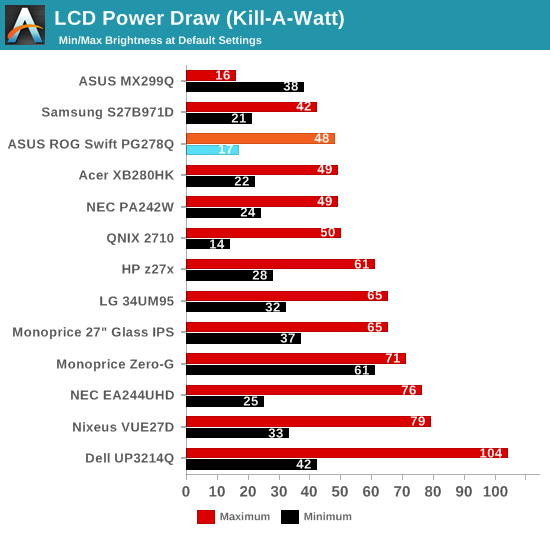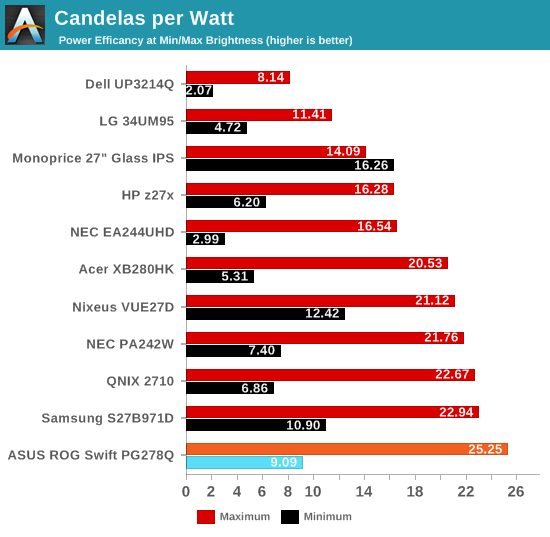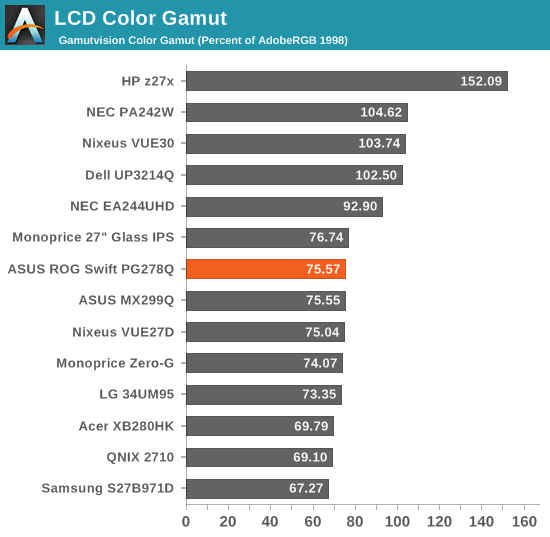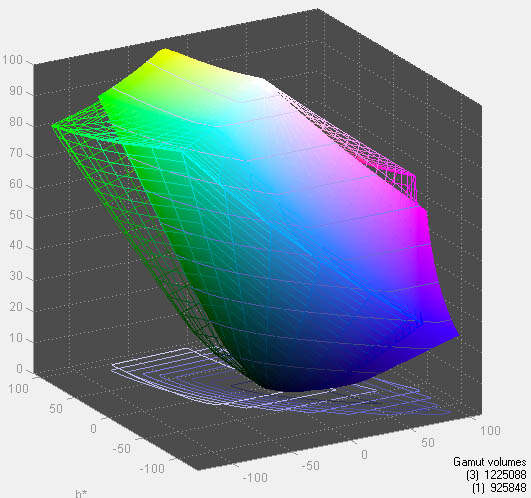ASUS ROG Swift PG278Q G-SYNC Monitor Review
by Chris Heinonen & Jarred Walton on February 13, 2015 10:00 AM ESTPower Use, Gamut, Input Lag
With a full white screen and the brightness set to maximum, the ASUS ROG uses 48 watts of power. Setting the backlight to the minimum setting reduces this down to 17 watts.


The ASUS ROG reproduces 75.57% of the AdobeRGB gamut. This puts it solidly in the sRGB color gamut, just about what we expected from looking at the earlier pre- and post-calibration results. No G-SYNC monitors have gone beyond the sRGB gamut at this point, and until there is a gaming oriented panel that is only available in a wide-gamut version, I don’t expect to see one. It just isn’t a critical feature for gaming compared to other things.

Like the other G-SYNC displays I have tested, the ASUS ROG has no inputs aside from a single DisplayPort. Because I have no CRT monitor that can run at the same native resolution as it, nor a DisplayPort compatible lag tester, I can’t produce an accurate input lag measurement for the display. Obviously this is not an ideal result for a gaming display, but any number I could produce I would have zero faith in.











101 Comments
View All Comments
tanooki - Friday, February 13, 2015 - link
Unfortunately you're misinterpreting refresh rate for response time.The ASUS monitor has 1ms response time while the
Acer: "one of the world’s first IPS monitors with a response time of only 4ms G-to-G"
DiHydro - Friday, February 13, 2015 - link
If it is 4 ms Gray to Gray, that means it should be able to achieve 144 Hz if the screen is refreshing at that. Required response time for 144 Hz is 6.944... ms. 4 ms on the dot would get you 240 Hz, and of course 1 ms should equal 1000 Hz.That does not mean these displays will not have input lag, another issue for FPS and fast paced games, or terrible picture quality, an issue for everyone and movies especially.
doggghouse - Tuesday, February 17, 2015 - link
If they advertise "4ms GtG," it is most likely closer to a 6ms average transition time. If you read the reviews on TFT Central, when they measure actual pixel response times, they are often about 2-3ms higher than the reported value. For example, the Swift is a supposed "1ms GtG" panel, but in practice the average transition time was about 3ms.In reality, the ghosting effect of slow pixel response times could be a minor problem for an IPS running at 120+ Hz, however... I'd take an IPS running at 120Hz over one at 60Hz any day... the blur caused by ghosting is minimal compared to the blur caused by 60Hz persistence compared to 120Hz persistence.
The one thing that incredibly fast pixel response times allow for is strobing, which makes LCD behave practically like a CRT display, meaning practically 0 motion blur. For now, IPS doesn't look like it can transition fast enough for a clean strobe.
yefi - Friday, February 13, 2015 - link
Sorry, I misread low for lower. TN is still the quickest to be sure, though as DiHydro points out, IPS should now cleanly manage transitions at 120 and 144Hz.theunwarshed - Saturday, February 14, 2015 - link
that's advertised, the true response time is closer to 3ms on "normal" OD settings for the Swift per: http://www.tftcentral.co.uk/reviews/asus_rog_swift...theunwarshed - Saturday, February 14, 2015 - link
if we're talking total input lag (signal processing+response time) than BenQ's XL2720Z is actually a little faster. it's a TN 144hz, 3d vision w/o g-sync @ $450. a better deal imo than the Swift.mackanz72 - Monday, February 16, 2015 - link
27" @ 1080p? And i thought 24" @ 1200p was bad.How in the world is that a better deal?
I'm not saying the Swift is a good deal, since it is really a crappy piece of junk seeing all the quality issues it has. Online shops are stockpiling refurbished units from Asus that few wants to touch with a ten foot pole.
But 27" and only 1080p in 2015? No way.
FlushedBubblyJock - Sunday, February 15, 2015 - link
One hopes that AMD can finally deliver it's freesync vaporware, but no one should hold their breath.I think Asus and their ROG is hoopla is half the tax.
Next we'll get a $300 over normal price 1nf1n1ty gamerz gsync so all the drooling ad controlled robotic braggers can forum it up.
Well at least it's not quite as bad as apple fans.
D. Lister - Thursday, March 12, 2015 - link
AMD will indeed deliver FreeSync. They've got a bunch of monitor manufacturers onboard for this (who admittedly would just need to add a few extra lines of code to their firmware for this, but still), so they can't just back out now.<speculation > The problem is with the way FS works. When the framerate is reasonably consistent, it would work fine, but if the framerate is jumping around, there would probably be some stuttering. Ultimately I suppose, as per AMD's MO of late, it would be another compromise between price and quality.</speculation>
Raphash - Wednesday, February 18, 2015 - link
I paid the nVidia tax... I was one of the lucky folks that got this monitor when it first came out. Boy was that an adventure!!! Constantly trying to find someone that had a stock of it. Anyways, I was also fortunate enough to get a great display in terms of backlight bleed etc. I have had ZERO issues with mine. Now that I have seen G-Sync in motion... I would have gladly paid $1,000 for this monitor. Fortunately, I got mine for $800. This monitor is truly the best gaming monitor I have ever owned!!! For me, it even beats out my old trusty Sony GDM-500 display and that's saying something!!